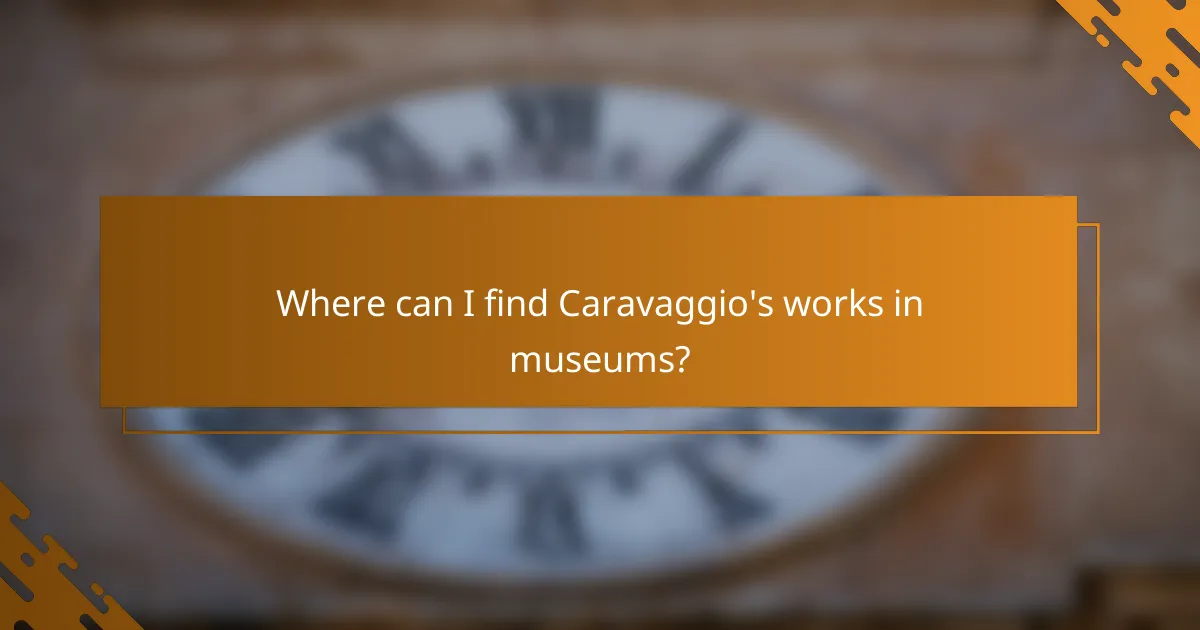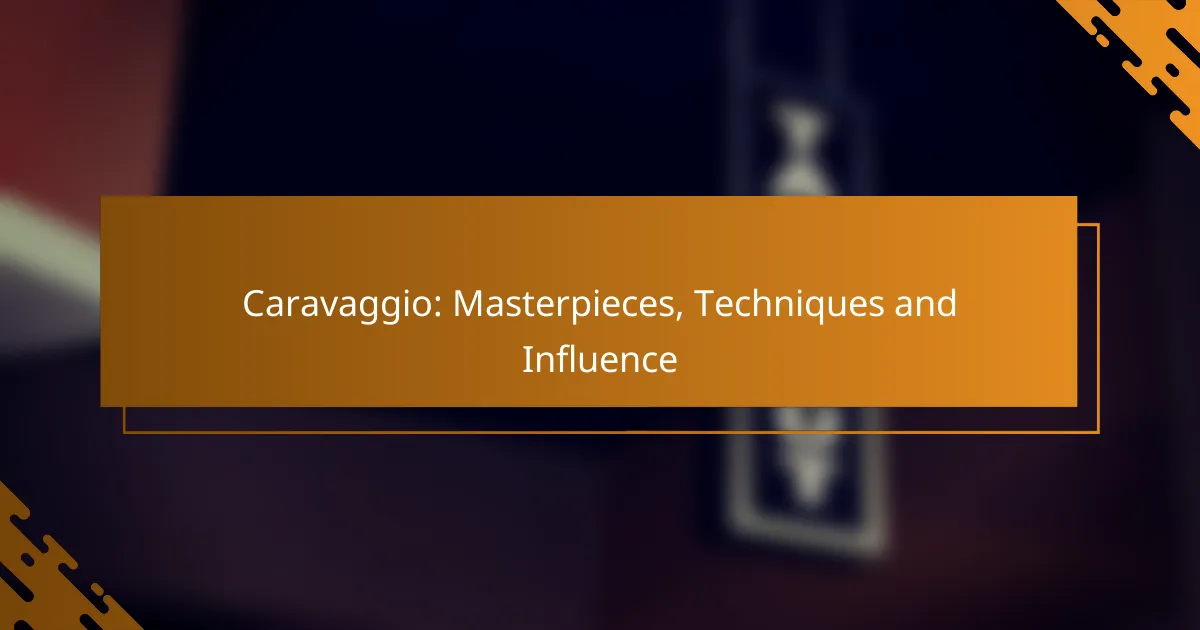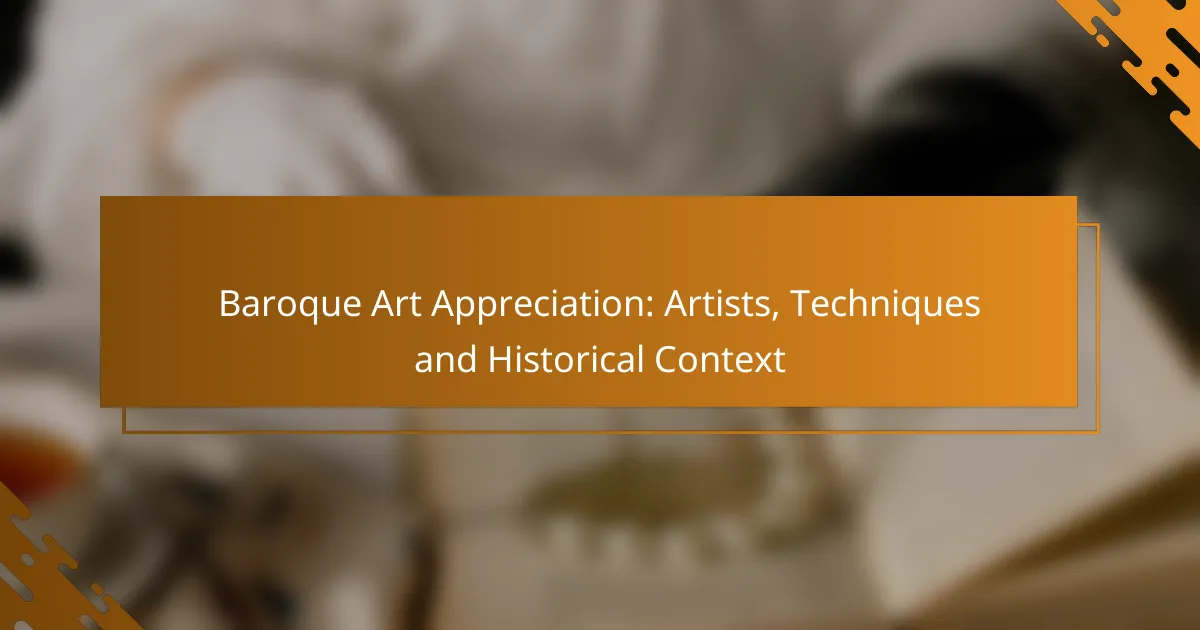Caravaggio, a pivotal figure in Baroque art, is celebrated for his masterpieces that exemplify the dramatic interplay of light and shadow, known as chiaroscuro. His paintings, often depicting intense biblical scenes, convey deep emotional resonance and have left a lasting impact on the art world, influencing generations of artists with his innovative techniques and realistic portrayals.

What are Caravaggio’s most famous masterpieces?
Caravaggio’s most renowned masterpieces include works that showcase his dramatic use of light and shadow, known as chiaroscuro, along with intense emotional expression. His paintings often depict biblical scenes, capturing moments of profound significance and human emotion.
The Calling of Saint Matthew
This painting illustrates the moment Jesus calls Matthew to follow him, emphasizing the theme of divine intervention. Caravaggio’s use of light highlights Matthew’s surprise and the transformative nature of the calling, creating a powerful visual narrative.
The figures are positioned in a dimly lit tavern, contrasting the sacred with the everyday, which is a hallmark of Caravaggio’s style. The dramatic lighting draws the viewer’s eye directly to the moment of revelation.
Judith Beheading Holofernes
In this striking work, Caravaggio depicts Judith as she beheads the Assyrian general Holofernes, capturing both the violence and the bravery of the act. The intense expressions and dynamic poses convey a sense of urgency and drama.
The stark contrast between the dark background and the illuminated figures enhances the emotional impact, making it a quintessential example of Caravaggio’s mastery of chiaroscuro. This painting challenges viewers to confront the themes of power and morality.
Amor Vincit Omnia
This painting portrays the allegorical figure of Cupid, symbolizing love’s triumph over all. Caravaggio’s depiction of Cupid as a mischievous yet innocent child invites viewers to reflect on the complexities of love and desire.
The rich colors and detailed textures showcase Caravaggio’s skill in rendering human forms, while the playful composition suggests a lighthearted yet profound message about the nature of love.
The Supper at Emmaus
This masterpiece captures the moment when the resurrected Christ reveals his identity to two disciples during a meal. Caravaggio’s use of light not only highlights Christ but also creates a sense of intimacy and revelation.
The expressions of astonishment on the disciples’ faces reflect their realization, making this work a powerful exploration of faith and recognition. The setting, a simple table, emphasizes the significance of the moment in an everyday context.
David with the Head of Goliath
In this dramatic portrayal, Caravaggio presents David holding the severed head of Goliath, symbolizing triumph and divine favor. The emotional intensity is palpable, with David’s expression reflecting both pride and sorrow.
The contrast between the youthful David and the grotesque head of Goliath serves to highlight the themes of heroism and the moral complexities of victory. This painting invites viewers to consider the cost of triumph and the weight of responsibility that comes with it.

How did Caravaggio influence Baroque art?
Caravaggio significantly influenced Baroque art through his innovative techniques and dramatic themes. His use of light and shadow, realistic portrayals, and intense emotional narratives set a new standard for artists in the Baroque period and beyond.
Use of chiaroscuro
Chiaroscuro, the technique of using strong contrasts between light and dark, was masterfully employed by Caravaggio to create depth and volume in his paintings. This method not only enhanced the three-dimensionality of figures but also directed the viewer’s attention to focal points within the composition.
Artists following Caravaggio adopted chiaroscuro to evoke emotion and drama, often using it to highlight key moments in their narratives. This technique became a hallmark of Baroque art, influencing countless painters across Europe.
Realism in religious themes
Caravaggio’s approach to religious themes was marked by a striking realism that depicted biblical figures as relatable and human. He often used ordinary people as models, which made sacred subjects more accessible and engaging to viewers.
This emphasis on realism challenged the idealized representations common in earlier art, prompting other Baroque artists to adopt similar techniques. The result was a more intimate connection between the audience and the divine, as seen in works by artists like Rembrandt and Velázquez.
Emphasis on dramatic storytelling
Caravaggio’s paintings are renowned for their dramatic storytelling, often capturing pivotal moments of tension and emotion. His compositions frequently feature dynamic poses and intense expressions, drawing viewers into the narrative.
This focus on storytelling influenced Baroque artists to create works that were not only visually striking but also rich in narrative depth. The use of dramatic lighting and composition became essential tools for conveying emotion and action, shaping the direction of Baroque art for generations.

What techniques did Caravaggio use in his paintings?
Caravaggio utilized a range of innovative techniques that emphasized naturalism and dramatic effects, which set him apart from his contemporaries. His mastery of light, shadow, and realistic detail created a powerful emotional impact in his works.
Naturalism and realism
Caravaggio’s paintings are renowned for their naturalism, which involves depicting subjects with a high degree of accuracy and detail. He often painted ordinary people, capturing their expressions and gestures in a way that made them relatable and lifelike.
This focus on realism extended to his choice of settings and props, often using everyday objects to enhance the authenticity of the scene. For instance, in works like “The Calling of Saint Matthew,” the figures are portrayed in a contemporary setting, making the biblical narrative more accessible to viewers of his time.
Tenebrism for dramatic effect
Tenebrism is a technique that Caravaggio perfected, characterized by stark contrasts between light and dark. This method not only added depth to his compositions but also heightened the emotional intensity of the scenes he depicted.
By using tenebrism, Caravaggio directed the viewer’s attention to specific elements within the painting, often illuminating the central figures while leaving the background in shadow. This technique creates a sense of drama and tension, as seen in “Judith Beheading Holofernes,” where the interplay of light and shadow enhances the narrative’s suspense.
Innovative use of light and shadow
Caravaggio’s innovative approach to light and shadow was groundbreaking, as he employed chiaroscuro to create a three-dimensional effect on flat surfaces. This technique involved using strong contrasts to model forms and convey volume, making his subjects appear more lifelike.
His strategic placement of light sources often mimicked natural illumination, which added a sense of realism to his works. For example, in “The Supper at Emmaus,” the light falls dramatically on the figures, emphasizing their expressions and the moment’s significance. This use of light not only enhances the visual appeal but also reinforces the emotional weight of the narrative.

Where can I find Caravaggio’s works in museums?
Caravaggio’s masterpieces can be found in several prominent museums across Europe. Key locations include the Uffizi Gallery in Florence, the National Gallery in London, and the Museo di Capodimonte in Naples, each housing significant works that showcase his unique style and techniques.
Uffizi Gallery in Florence
The Uffizi Gallery is home to Caravaggio’s renowned painting “Medusa,” which exemplifies his dramatic use of light and shadow. Visitors can appreciate the intense realism and emotional depth that characterize his work.
When visiting, consider purchasing tickets in advance to avoid long lines, especially during peak tourist seasons. The gallery often hosts special exhibitions that may include additional Caravaggio pieces, enhancing the experience.
National Gallery in London
The National Gallery features several of Caravaggio’s significant works, including “The Supper at Emmaus.” This painting is notable for its striking composition and the masterful depiction of human emotion.
To make the most of your visit, check the gallery’s schedule for guided tours that focus on Caravaggio’s contributions to art. The National Gallery also offers educational resources that provide deeper insights into his techniques and influence.
Museo di Capodimonte in Naples
Museo di Capodimonte houses Caravaggio’s “The Seven Works of Mercy,” a powerful piece that reflects his commitment to realism and social themes. This museum is particularly significant as it is located in Naples, where Caravaggio spent a considerable amount of time.
Plan your visit to coincide with less crowded times, such as weekdays, to fully appreciate the artwork without distractions. The museum often features guided tours that delve into Caravaggio’s life and the historical context of his works.

What are the key themes in Caravaggio’s art?
Caravaggio’s art is characterized by several key themes, including religious devotion, human emotion and suffering, and the contrasts between light and dark. These themes not only define his unique style but also reflect the socio-religious context of his time.
Religious devotion
Religious devotion is a prominent theme in Caravaggio’s works, often depicted through dramatic scenes from the Bible. His paintings frequently capture moments of divine intervention, emphasizing the human experience of faith and spirituality.
For instance, in “The Calling of Saint Matthew,” Caravaggio illustrates the moment of Matthew’s conversion with a sense of immediacy and realism, inviting viewers to witness the transformative power of faith. This approach made religious themes accessible and relatable to the common people of his era.
Human emotion and suffering
Caravaggio’s art powerfully conveys human emotion and suffering, often portraying characters in moments of intense psychological conflict. His subjects display raw emotions, making their experiences resonate with viewers.
In “Judith Beheading Holofernes,” the expressions of Judith and her maid reflect both determination and horror, showcasing the complexity of human feelings in dire situations. This focus on emotional depth allows audiences to connect with the characters on a personal level.
Contrasts between light and dark
The use of chiaroscuro, or the contrast between light and dark, is a hallmark of Caravaggio’s technique. This method not only enhances the dramatic effect of his paintings but also serves to highlight the moral and thematic elements of the narrative.
In works like “The Supper at Emmaus,” the stark contrasts draw attention to the figures and their expressions, creating a sense of depth and three-dimensionality. This technique emphasizes the tension between the sacred and the profane, a recurring motif in Caravaggio’s oeuvre.



